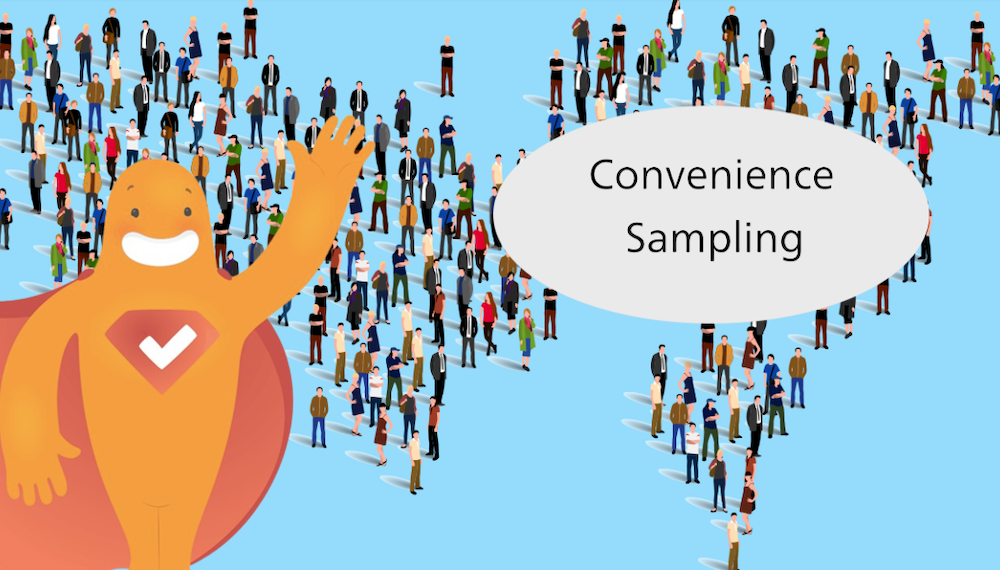Many surveys are concerned with people’s age, gender, income, education level, and other demographic information. These surveys want to know this information because they’re targeting a specific portion of the population. On the other hand, some surveys aren’t concerned with any specifics other than proximity to the researcher. These “down and dirty” surveys use the convenience sampling method. There are a number of advantages to convenience sampling, but also some disadvantages. Let’s dive in!
Create your FREE Convenience Sampling Survey, Poll, or Questionnaire now!
Convenience Sampling Definition
The convenience sampling method involves collecting data from a conveniently available pool of respondents. There are no criteria required to be included in the sample and it does not matter if the sample is representative of the entire population; everyone is eligible. With the sample readily available and no specific audience in mind, this makes convenience sampling quick, easy, and inexpensive. Of course, there are problems with convenience sampling, which we’ll highlight shortly.
Convenience Sampling Examples
To better understand the convenience sampling method, it helps to to look at some examples. Here are four examples of convenience sampling research.
- A student is researching typical alcohol consumption of college students. He surveys all the students in his dorm and asks them how often they drink alcohol and how much they drink. Of course, those living in dorms may be less likely to drink as much as those living off campus, so his sample may not be representative of all college students, introducing bias, but those surveyed are located conveniently to him for the purposes of his survey.
- A business wants feedback on a new product offering. They survey people as they leave the store to get their feedback on the new product. While they’re only surveying people who may have been interested in the product in the first place, introducing bias since they were already in the store, it was a convenient way to capture feedback for further research.
- An online platform for teens wants to know how often a user is likely to participate in a discussion. The site doesn’t require membership information, so there is no way to drill down to specifics (age, gender, location, etc). Instead, the site deploys random pop-up surveys to 300 users. While these users may not represent the majority of users, they were conveniently accessible to reach out to through the website.
- A news outlet wants to know which presidential candidate most people are likely to vote for. So, they survey people in-person on the street at a busy intersection. There may be a lot of bias (the city does not represent the country as a whole, after all, and could be a very red or blue location) but the participants were conveniently accessible to the researcher.
Other Types of Convenience Sampling
Within the realm of convenience sampling there are two other types of sampling.
- Consecutive sampling. While samples are still chosen based on convenience, there’s not a set number of participants. Instead, the goal is to reach a conclusion. So, each survey is analyzed once it’s complete before administering the next survey. Once the researcher has a conclusive result, the surveying ends.
- Self-selective sampling (aka volunteer sampling). This sampling method uses volunteers to reach the desired sample size. People sign up to be part of the survey often because there is an incentive involved. For example, medical research studies they may offer financial compensation or free trials of a particular drug that could benefits someone with a particular condition.
Advantages of Convenience Sampling
Convenience sampling research has many benefits, which make it a popular choice for researchers. Here are five pros of convenience sampling.
1. Fast Data Collection
When time is an issue, convenience sampling offers a quick way to collect data. Because there are no demographic specifics or any other set of “rules,” convenience sampling can be conducted quickly, reaching out to anyone in close proximity or anyone online.
2. Inexpensive Data Collection
Researchers may spend a lot of money on other types of sampling methods because they are focusing on specific demographics. Finding a target audience, and marketing to them, can be expensive versus simply surveying anyone within your proximity. Students, startups, and small businesses with limited funds often turn to convenience sampling.
3. Easy Data Collection
Because the researcher is only surveying people within his or her proximity, data collection is easy (as discussed within the previous examples above). By simply surveying those near, quotas can quickly be met and data collection time can be reduced.
4. Fewer (or No) Rules
Most surveys have “rules,” i.e. a checklist of who their target audience is. With convenience sampling, data collection doesn’t follow any rules; the researcher isn’t seeking out a specific audience. So, they don’t need to worry about age, gender, race, or any other demographic questions.
5. Hypothesis Formation Assistance
Convenience sampling is very important when it comes to exploratory research. Some researchers use convenience sampling as a first step in order to form hypotheses. After forming a hypothesis based on the convenience sampling, they may then spend the additional time and money on a different type of sampling method to get a clearer picture.
Drawbacks of Convenience Sampling
Unsurprisingly, there can be convenience sampling disadvantages, often due to sampling bias. Here are problems with convenience sampling.
- Because the sample was not chosen randomly, but rather through a survey of those in close proximity, the sample will never be fully representative of the population being studied.
- Accuracy of data collected can be compromised since only easily contacted participants are reached.
- Conclusions rely on the subjective judgment of the researcher and the subjective motivations of the participants leading to further survey bias.
- Researchers may be subjective in how they choose their participants (e.g., by stopping the passersby who appear friendliest), causing additional survey bias.
Reducing Survey Bias in Convenience Sampling
The best way to reduce bias in convenience sampling is by conducting an online survey. With an online survey, researchers aren’t limited to those in close proximity; they can easily survey people around the country and the world to come to better, more accurate conclusions. In addition, many online survey programs offer advanced statistical tools that can be used to analyze survey data to determine validity, reliability, and statistical significance. Be sure to read our blog on the 14 Advantages of Online Surveys. And, just because we’re an online survey company, doesn’t mean we don’t recognize some of the disadvantages. We address those in the blog too!
Convenience Sampling with Online Image Surveys
Just because convenience sampling is “convenient,” doesn’t mean that you’ll get the responses you need. To improve your response rates, consider using a different method or use online surveys with photos. Our picture surveys boost engagement, help trigger respondent emotion and memory, and cross language barriers. They’re ideal when going about this type of sampling!
Below is an example of a convenience sampling survey with images for a school. It’s convenient because the researcher is only asking questions of those within their school, and the imagery helps make it more engaging for respondents.

Conclusion
Convenience sampling is a go-to method of research for those looking to conduct quick, cheap, and easy surveys. While this approach has some drawbacks, it’s also a great way to get started on a survey that will inform bigger future ambitions. A convenience survey can provide some initial data in which to create and conduct a survey with a more thorough segment of the population. Be sure to check out our blog 8 Types of Survey Sampling + Pros & Cons, Errors & Bias, and More. Of course, however you want to conduct your survey, we’ve got you covered. SurveyLegend lets you start for free, and has dozens of beautiful and responsive templates from which to choose.
What types of sampling method(s) do you use when surveying? Which provides the best results? Let us know in the comments!
Create your FREE Convenience Sampling Survey, Poll, or Questionnaire now!
Frequently Asked Questions (FAQs)
Convenience sampling means collecting data from a “conveniently available” pool of respondents. Everyone is eligible, they must just be within easy reach of the surveyor.
Convenience sampling is usually used when funds are lacking; surveyors can simply present questionnaires to those near them, regardless of demographic data.
It can be. Because convenience sampling only looks at a small subset of the population, it may not be reflective of the greater population.
Using an online survey is ideal for preventing common convenience sampling drawbacks, as it can cast a wide net which provides a more accurate picture of the situation.




